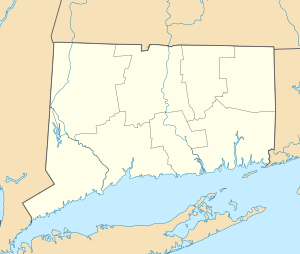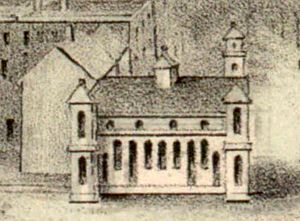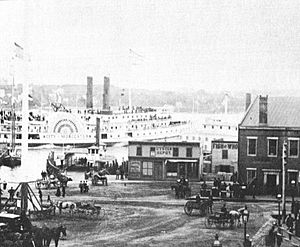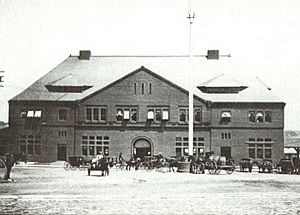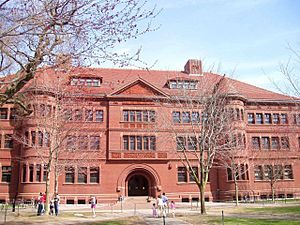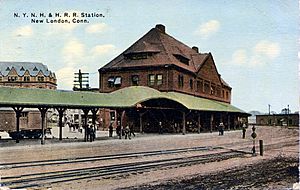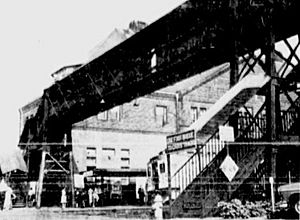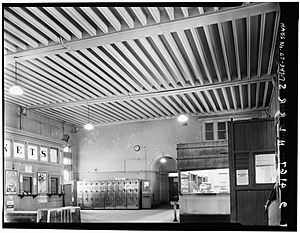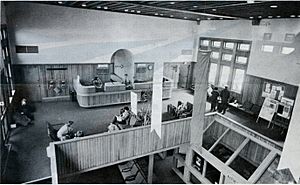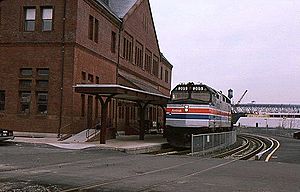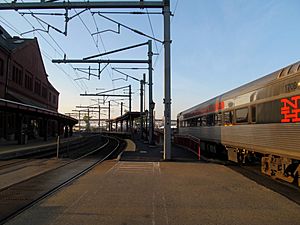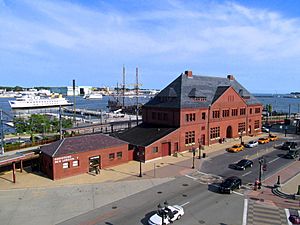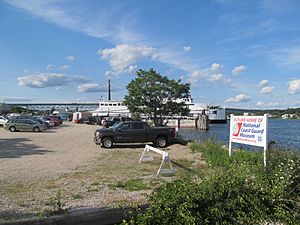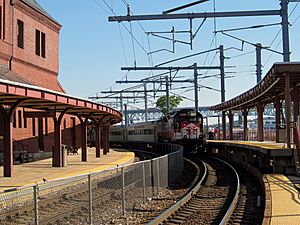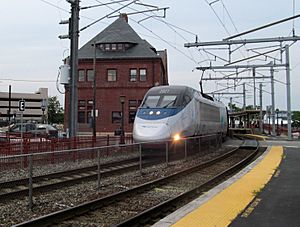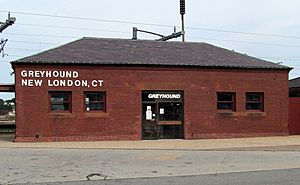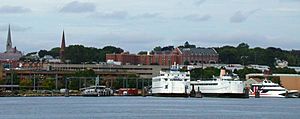New London Union Station facts for kids
Quick facts for kids
New London, CT
|
||||||||||||||||||||||||||||
|---|---|---|---|---|---|---|---|---|---|---|---|---|---|---|---|---|---|---|---|---|---|---|---|---|---|---|---|---|
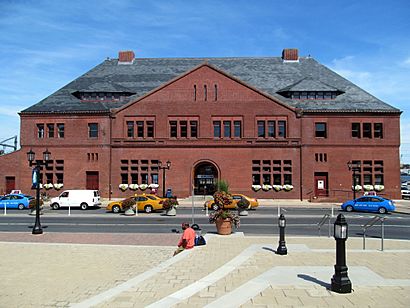
Front view of New London Union Station in July 2012
|
||||||||||||||||||||||||||||
| Location | 27 Water Street, New London, Connecticut United States |
|||||||||||||||||||||||||||
| Owned by | New London RR Company (station) Amtrak (track and platforms) |
|||||||||||||||||||||||||||
| Line(s) | Northeast Corridor New England Central Railroad |
|||||||||||||||||||||||||||
| Platforms | 1 side platform 1 island platform |
|||||||||||||||||||||||||||
| Tracks | 3 | |||||||||||||||||||||||||||
| Connections | ||||||||||||||||||||||||||||
| Construction | ||||||||||||||||||||||||||||
| Disabled access | Yes | |||||||||||||||||||||||||||
| Other information | ||||||||||||||||||||||||||||
| Station code | Amtrak code: NLC | |||||||||||||||||||||||||||
| History | ||||||||||||||||||||||||||||
| Opened | 1848 (NLW&P) 1852 (NH&NL) |
|||||||||||||||||||||||||||
| Rebuilt | 1861(NLW&P) 1864 (NLN) 1886–1887 (Union Station) Renovations: 1976–77, 2002–03 |
|||||||||||||||||||||||||||
| Electrified | 25,000 VAC overhead catenary (tracks 1 and 2 only) | |||||||||||||||||||||||||||
| Traffic | ||||||||||||||||||||||||||||
| Passengers (2019) | 164,454 |
|||||||||||||||||||||||||||
| Services | ||||||||||||||||||||||||||||
|
||||||||||||||||||||||||||||
|
||||||||||||||||||||||||||||
|
Union Station
|
||||||||||||||||||||||||||||
| Architect | Henry Hobson Richardson | |||||||||||||||||||||||||||
| NRHP reference No. | 71000913 | |||||||||||||||||||||||||||
| Added to NRHP | June 1971 | |||||||||||||||||||||||||||
The New London Union Station is a cool, old train station in New London, Connecticut. It sits on the Northeast Corridor, which is the busiest railway in the United States! This station is super important for train travel in southeastern Connecticut.
Most Amtrak Northeast Regional trains stop here. A few super-fast Acela Express trains also make a quick stop. Plus, some ConnDOT Shore Line East commuter trains end their journey here. This makes New London the eastern end of commuter rail in Connecticut.
Union Station is like a central hub for different types of transportation. You can catch local and long-distance buses here. You can also find ferries that take you to Long Island, Fishers Island, New York, and Block Island, Rhode Island. The building you see today was built in 1887. It's the sixth train station New London has had. It's also one of the oldest stations still used on the Northeast Corridor. A famous architect named H. H. Richardson designed it. It was his last and biggest train station project.
Contents
Station History and Design
Many Stations Before This One
The current Union Station is actually the sixth train station in New London. The first one opened in 1848. It was an old building on Water Street that was turned into a station.
In 1852, a new, bigger station was built. This happened when the New Haven and New London Railroad arrived. But this station soon became too small. People started asking for a new one as early as 1859.
Over the years, different railroad companies used the station. The 1852 station was later replaced by another two-story building. This building was not very popular. People complained about it often. When it burned down in 1885, many locals were happy. They felt it had been around too long.
The Famous H.H. Richardson Design
After the old station burned, the Central Vermont Railroad decided to build a much larger, better station. They hired a famous American architect named Henry Hobson Richardson. He was known for designing many public buildings, including other train stations.
Richardson started designing the new New London station in 1885. It was one of the last projects he worked on before he passed away in 1886. Even though he died, the design was very good. Many people think it's his best train station design.
Union Station is special because it doesn't look like Richardson's other stations. It's built with brick and has a simple, strong look. Its design was inspired by Sever Hall at Harvard University, which Richardson also designed. The station has a similar shape, brick color, and arched entrance.
The building is two and a half stories tall. It has many of Richardson's special touches. These include its unique roof, a big arched entrance, and beautiful brickwork. The bricks are laid in different patterns, which makes the walls interesting to look at. Inside, the waiting room was designed to be very open. It had no columns in the middle. This was possible because the upper floor was hung from the roof!
Construction on the new station began in September 1886. It opened in 1887. It was called a "union station" because it connected two different railroad lines. In 1889, the Thames River Bridge opened. This bridge connected the station to other rail lines. It completed the train link from New York to Boston.
In 1912, a footbridge was built. It connected the station to the ferry docks. This made it safer for people walking to the ferries.
Saving the Station
Train service north from New London stopped in 1949. But trains running east and west have continued to use the station. Over time, the station building started to get old and worn out.
In the 1960s, some city leaders wanted to tear down the station. They wanted to build a shopping mall there. This started a long fight to save the building. A small group of people wanted to restore it.
In 1971, Union Station was added to the National Register of Historic Places. This helped protect it. It meant that federal money could not be used to tear it down. Many local people were upset by this. They felt outsiders were stopping their city's plans.
A group of local activists formed the Union Railroad Station Trust. They wanted to fix up the station. In 1975, a company called Union Station Associates bought the building. This finally saved the station from being torn down.
They spent a lot of money to completely fix up the station. The outside was made to look like it did in 1885. The inside was changed a bit to add space for restaurants and shops. New, wider platforms were also built for passengers. The renovated station was celebrated in 1976. It was the first train station in the country to be restored for Amtrak to use.
New Life for the Station
The renovated station became popular with businesses. But by the late 1990s, the owners were getting ready to retire. The city thought about buying the station to turn it into a museum.
In 2001, Amtrak built new high-level platforms. These platforms were needed for the new, fast Acela Express trains. This helped the old 19th-century station work well for 21st-century trains.
Around 2002, the station was bought by the New London Railroad Company. They started a second big renovation. They put on a new roof and fixed the brickwork. They also made the waiting room look like it did originally. The changes from the 1976 renovation were removed. The old baggage room was fixed up for Greyhound buses. Today, Amtrak and Greyhound rent space from the company.
There were plans for a tall footbridge to connect the station to the ferry docks. But these plans were stopped in 2007.
Shore Line East Trains
In 1996, some Shore Line East commuter trains started coming to New London. These trains connect New London to places like New Haven. More trains were added over the years.
In 2013, weekend Shore Line East service also began. This made it easier for people to travel to New London on weekends.
Future Plans and Coast Guard Museum
Since 2006, people have been studying how to make the station area even better. They want to improve how people walk around and make the bus area bigger.
The National Coast Guard Museum is planned to be built near Union Station. A new building for the museum will be built east of the tracks. It will also have a new ferry terminal. A pedestrian bridge will connect the museum to the station and the train platforms. This will make it safer for people to get to the trains and ferries.
In 2015, the station was sold to a company owned by James Coleman Jr. He is the chairman of the Coast Guard Museum Association. He plans to renovate the station further. A restaurant serving local food is now on the first floor. The second floor will be used for things related to the museum.
As of 2019, the first part of the museum construction was expected to start in 2020. The footbridge will be built in a later phase.
Station Layout
New London station has a unique layout. This is because of a street crossing and a sharp curve in the tracks. There are two main train tracks for the Northeast Corridor. These are right next to the station. There's also a freight track further away.
Both main tracks have high-level platforms. These were added in 2001 for the fast Acela Express trains. High platforms make it easier to get on and off these trains.
The southbound track has a low platform behind the station. This leads to a short high platform. The northbound track has a high platform behind the station building. Because of the curve, the high platforms are set back a little. This means special ramps are used to bridge the gap to the train.
The northbound platform can also be used as an island platform. This would happen if passenger trains started using the freight track again. Most Shore Line East trains now use the freight track. A special metal ramp on the high platform helps people with disabilities board these trains.
The southbound platform is right next to the station building. But to get to the northbound platform, you have to cross both main train tracks. The planned footbridge for the Coast Guard Museum will fix this. It will let people reach the northbound platform safely without crossing the tracks.
Train and Bus Services
All Amtrak Northeast Regional trains that go east of New Haven stop at New London. This is about nine trains each way every day. A few Acela Express trains also stop here. Most Acela trains usually go straight through without stopping.
Shore Line East trains also serve New London. These trains have a limited schedule on weekdays and weekends. You can use Shore Line East tickets on some Northeast Regional trains too.
There's a future plan for a "Central Corridor Rail Line." This would run north from New London to places like Norwich and Brattleboro, Vermont. But this service is not funded yet.
Connecting to Other Transportation
Several ferry services leave from docks near the station. The Cross Sound Ferry goes to Orient Point on Long Island. It runs almost every hour all year. The Block Island Fast Ferry is a high-speed boat. It goes to Block Island several times a day in the summer. The Fishers Island Ferry goes to Fisher's Island all year.
Greyhound Bus Lines offers some long-distance bus service from Water Street. These buses travel along the I-95 highway. You can connect to other routes in Boston, New Haven, and New York City.
Union Station is also a main stop for Southeast Area Transit (SEAT) local buses. These buses connect New London to nearby towns. These include Norwich, Groton, and Foxwoods Casino. SEAT buses stop at a shelter north of the station. Here are some of the SEAT routes:
- 1 Norwich / Mohegan Sun / New London – Route 32
- 2 Norwich / Groton/ New London – Route 12
- 3 Groton / New London / Niantic
- 12 Jefferson Avenue / Crystal Mall / New London Shopping Center / Senior Center
- 13 Shaws Cove / L & M Hospital / Ocean Beach
- 14 New London Mall / Waterford Commons / Crystal Mall / New London Shopping Center
- 15 New London / Waterford – Evening Service
- 101 Norwich / Mohegan Sun / New London – Route 32
- 108 New London / Groton / Mistick Village / Foxwoods
The 9 Town Transit route 643 also serves Union Station. You can also find taxis in front of the station.


